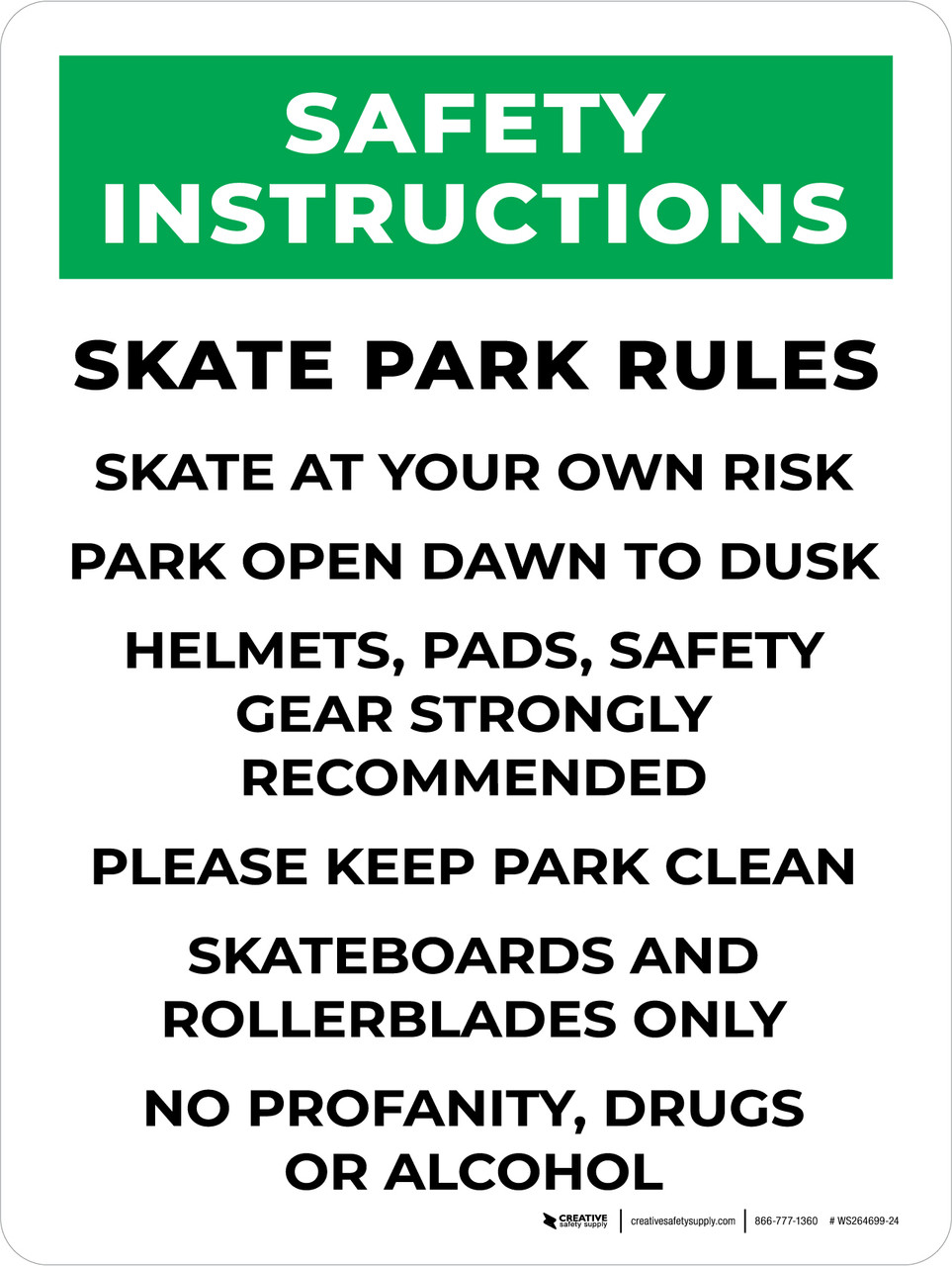
Skateboarding Park Safety Rules: A Comprehensive Guide
Skateboarding is a thrilling and rewarding sport, offering a unique blend of adrenaline, skill, and creativity. Skate parks provide dedicated spaces for skaters of all levels to hone their abilities and enjoy the camaraderie of the skateboarding community. However, the inherent risks associated with skateboarding necessitate a strong emphasis on safety. This comprehensive guide delves into the essential safety rules and guidelines that every skater should adhere to, ensuring a fun and injury-free experience within the skate park environment.
I. Understanding the Risks
Before diving into the specifics of safety rules, it’s crucial to acknowledge the inherent risks associated with skateboarding. The sport involves high-speed maneuvers, jumps, and drops, all of which can lead to serious injuries if not approached with caution and proper technique. Common injuries include:
- Head injuries: Falls, collisions, and impacts with obstacles can result in concussions, skull fractures, and other severe head traumas.
- Bone fractures: Broken bones in the wrists, arms, legs, and ankles are frequent occurrences, particularly during falls and landings.
- Sprains and strains: Ligament and muscle injuries are common, stemming from forceful movements and awkward landings.
- Abrasions and lacerations: Falls can lead to skin abrasions, cuts, and scrapes.
- Internal injuries: Severe impacts can cause internal bleeding or organ damage.
These risks are not insurmountable; however, they highlight the importance of adhering to safety regulations and practicing responsible skateboarding.
II. Essential Safety Gear
Protecting oneself from potential injuries is paramount. The use of appropriate safety gear is non-negotiable:
- Helmet: A properly fitted helmet is the most critical piece of safety gear. It should meet safety standards and be snugly secured to the head.
- Knee pads: Knee pads provide crucial protection against impact during falls.
- Elbow pads: Elbow pads safeguard the elbows from abrasions and fractures.
- Wrist guards: Wrist guards are essential for preventing wrist injuries, which are common in skateboarding.
The quality of safety gear matters. Invest in well-made, durable pads that offer adequate protection. Ensure that your gear fits correctly and comfortably to avoid hindering your movement or compromising safety.
III. Pre-Skate Preparation
Before stepping onto the ramps and rails, it’s vital to prepare oneself both physically and mentally:
- Warm-up: A proper warm-up routine prepares your muscles and joints for the physical demands of skateboarding. This includes stretching and light cardio.
- Check your gear: Inspect your skateboard, ensuring that the wheels are securely attached, the trucks are tight, and there are no loose parts. Check your safety gear for any damage or wear and tear.
- Hydration: Staying hydrated is crucial, especially during periods of intense activity. Carry water to replenish fluids lost through sweat.
- Awareness of surroundings: Take a moment to survey the skate park, observing the layout, the other skaters, and any potential hazards.
IV. Skate Park Etiquette and Safety Rules
Respecting others and adhering to the unwritten rules of the skate park is essential for a safe and enjoyable experience:
- Yield to others: Allow experienced skaters to have priority on ramps and obstacles. Less experienced skaters should yield to those with greater skill.
- No drop-ins: Avoid dropping into a ramp or bowl when another skater is already using it. This is a major cause of collisions and accidents.
- Keep a safe distance: Maintain a safe distance from other skaters to avoid collisions. This is especially important on ramps and transitions.
- Communicate: Use verbal communication to alert others of your intentions. Call out "coming through" or "line" to let others know your approach.
- Avoid distractions: Do not engage in distractions such as using your phone while skating. Focus on your surroundings and your movements.
- Respect park rules: Adhere to the specific rules and regulations set by the skate park management. This includes age restrictions, hours of operation, and any other guidelines.
- Clean up after yourself: Dispose of any trash responsibly and leave the skate park clean for others.
- Be aware of your abilities: Do not attempt tricks or maneuvers beyond your skill level. Progress gradually and avoid pushing your limits beyond your capabilities.
- Take breaks: Regular breaks are crucial for preventing fatigue and avoiding errors in judgment.
- Be mindful of obstacles: Be aware of any fixed obstacles in the skatepark and avoid collisions with them.
- Respect the environment: The skate park is a shared space. Keep the area clean and respect the equipment.
V. Emergency Procedures
Knowing what to do in case of an emergency is critical.
- First Aid: If an accident occurs, provide basic first aid if you’re qualified to do so.
- Call for help: Contact emergency services if necessary.
- Reporting accidents: Report accidents to skate park management to help improve safety measures.
VI. Conclusion
Skateboarding is a thrilling and exhilarating activity, but it’s important to approach it with caution and respect for safety. By following these guidelines, skaters of all levels can significantly reduce their risk of injury and enjoy the sport to the fullest. Remember, safety is not just about personal well-being; it’s also about ensuring a respectful and enjoyable environment for everyone at the skate park. Prioritize safety and enjoy the ride!



